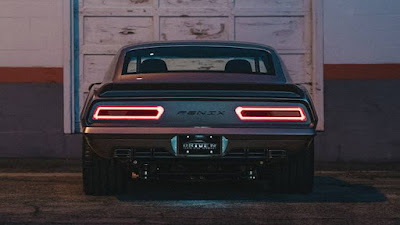Muscle Reborn - There’s something timeless about classic American muscle cars—especially when they’re reimagined with a modern twist that pushes the boundaries of power, design, and craftsmanship. These machines are more than just vehicles; they’re moving works of art, pulsing with personality and roaring performance. Among the many showstoppers to hit the scene recently, one build continues to steal attention and admiration: the incredible custom 1969 Chevrolet Camaro Fenix.
 |
| This ferocious beauty, the 1969 Chevrolet Camaro Fenix by Sean Smith teamed up with Mikey Dascoli and the crew at Driven Speed Shop, unveiled at the 2023 Grand National Roadster Show in Pomona, California, wasn’t just another restomod—it was a statement. (Picture from: CarBuzz) |
 Unveiled during the 2023 Grand National Roadster Show in Pomona, California, this ferocious beauty wasn’t just another restomod—it was a statement. At the heart of this car is a thunderous 1,180-horsepower supercharged 427 LS7 V8, a number that alone would make anyone take notice. But behind those staggering figures lies a deeper story: one that begins with designer Sean Smith, a name that carries serious weight in the custom automotive world.
Unveiled during the 2023 Grand National Roadster Show in Pomona, California, this ferocious beauty wasn’t just another restomod—it was a statement. At the heart of this car is a thunderous 1,180-horsepower supercharged 427 LS7 V8, a number that alone would make anyone take notice. But behind those staggering figures lies a deeper story: one that begins with designer Sean Smith, a name that carries serious weight in the custom automotive world. |
| The 1969 Chevrolet Camaro Fenix was meticulously fine-tuned for precision and fitment, featuring a reworked front end with a new valance and bumper, and sits perfectly atop a Roadster Shop Fast Track chassis. (Picture from: HotRod) |
Sean Smith isn't just any designer. With over two decades of experience, his resume reads like a who's who of automotive excellence, including time spent shaping projects for Saleen Automotive, Rockstar Games, Ringbrothers, and SpeedKore. Smith has always had a knack for blending innovation with aggressive styling, and that talent found its perfect canvas when car enthusiast Michael Shields approached him. Shields had one goal in mind—to create a Camaro that would outshine the one Smith previously designed for the 2019 SEMA Show.
 |
| The 1969 Chevrolet Camaro Fenix is dressed in a sleek Silver base, offset by accents in Liquid Champagne and Satin Charcoal Grey, creating a sophisticated color palette that walks the line between vintage charm and modern edge. (Picture from: HotRod) |
That challenge led to the birth of Fenix, a name as fierce as the machine itself. To bring the vision to life, Smith teamed up with Mikey Dascoli and the crew at Driven Speed Shop. Despite the geographical distance, their collaboration took place virtually, with Smith sketching out his designs and the build team translating them into physical perfection.
 |
| The 1969 Chevrolet Camaro Fenix features an interior inspired by high-end European sports cars, brought to life through Smith’s design expertise, with elements like the dashboard, door panels, and center console crafted from 3D CAD models and executed with precision to create a cabin that’s both refined and race-ready. (Picture from: HotRod) |
The visual appeal of the Fenix is undeniable. It’s dressed in a sleek Silver base, offset by accents in Liquid Champagne and Satin Charcoal Grey, creating a sophisticated color palette that walks the line between vintage charm and modern edge. Smith reworked the front end with a new valance and bumper, while the rear received custom light panels and a 3D-printed trunk spoiler—subtle yet bold enhancements that elevate the car’s overall presence. Every inch of the body was fine-tuned for precision and fitment, sitting perfectly atop a Roadster Shop Fast Track chassis.
 |
| The 1969 Chevrolet Camaro Fenix is powered by a thunderous 1,180-horsepower supercharged 427 LS7 V8—an output that commands instant attention. (Picture from: HotRod) |
What really seals the deal is how form meets function. HRE RS103 wheels, 18 inches up front and 19 inches in the rear, are wrapped in sticky Michelin Pilot Sport 4 tires, giving the Fenix the grip it needs to manage its immense power. The engine, built by Wegner Motorsports, pairs with a Tremec T56 six-speed transmission that ensures all 1,180 ponies are ready to run when called upon. Meanwhile, the engine bay—meticulously crafted by Driven Speed Shop—and the flawless paintwork by Kandy Shop Creations in Mesa, Arizona, add finishing touches that push the build into showstopper territory.
 |
| The 1969 Chevrolet Camaro Fenix was meticulously fine-tuned for precision and fitment, featuring a custom rear light panels, a 3D-printed trunk spoiler. (Picture from: CarBuzz) |
Step inside, and the transformation continues. The interior pulls inspiration from high-end European sports cars, thanks to Smith’s design expertise. Components like the dashboard, door panels, and center console were all born in 3D CAD software and realized with precision, resulting in a cabin that feels as refined as it is race-ready.
 More than just a muscle car reborn, the 1969 Chevrolet Camaro Fenix is a passion project come to life—a true collaboration between visionaries and craftsmen. It’s a reminder that when talent, technology, and a little bit of boldness come together, even legends can rise from the ashes and burn brighter than ever. *** [EKA | FROM VARIOUS SOURCES | HOTROD | CARBUZZ | ID.MOTOR1 ]
More than just a muscle car reborn, the 1969 Chevrolet Camaro Fenix is a passion project come to life—a true collaboration between visionaries and craftsmen. It’s a reminder that when talent, technology, and a little bit of boldness come together, even legends can rise from the ashes and burn brighter than ever. *** [EKA | FROM VARIOUS SOURCES | HOTROD | CARBUZZ | ID.MOTOR1 ]Note: This blog can be accessed via your smart phone
